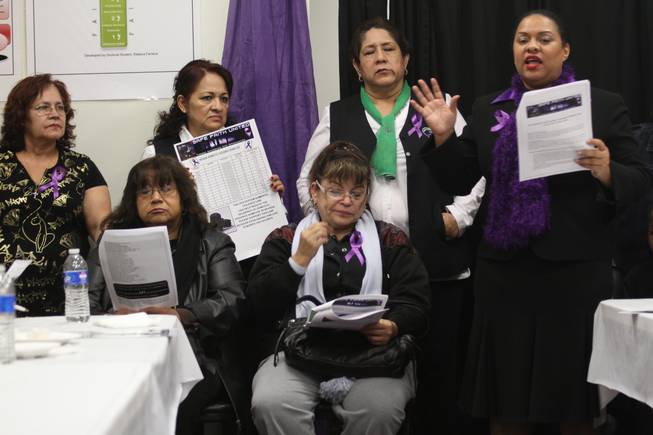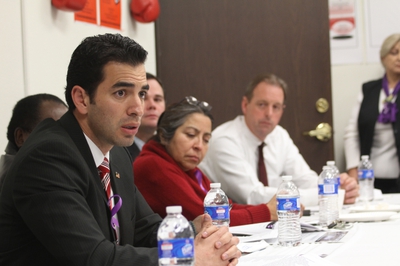
Rebeca Ferreira (far right), founder of domestic abuse victim advocacy organization Safe Faith United, speaks to state legislators on Jan. 20 about strengthening domestic violence laws.
Tuesday, Feb. 7, 2012 | 2 a.m.
Related Stories
Rebeca Ferreira knows firsthand about the isolation of being an immigrant victim of domestic violence, and she knows firsthand how the lack of data about such crimes is handcuffing agencies serving those women.
Before she started Safe Faith United in 2009 to help Las Vegas domestic violence victims, she escaped an abusive relationship. Her agency helps domestic violence victims, especially minorities, who she said have been mishandled by traditional services and unaccounted for in data.
“Nevada is the embarrassment of the nation,” she said as she reviewed domestic violence statistics for the state in her office adorned with photos of victims. “Something must be done.”
Since Hispanic is an ethnicity and not a race, finding accurate domestic violence data is problematic, both in Nevada and across the nation.
Law enforcement agencies across the country do not follow a single system for reporting the ethnicity of a victim or perpetrator. The lack of such detail, advocates for abuse victims say, not only keeps law enforcement agencies from formulating strategies to curtail domestic violence; it also causes difficulty for aid organizations to land funding for services targeting Hispanics and immigrants.
“Services are funded by need,” said Rebecca Balog, director of the Pennsylvania-based Women of Color Network. “If needs aren’t clearly spelled out and quantifiable, then the money won’t come. There is a huge need for Hispanic families, but the statistics aren’t there to support funding.”
A recent federal Centers for Disease Control report found nearly half of all women living in Nevada at the time of the survey had experienced domestic violence in their lifetime.
Late last year, the Violence Policy Center issued a report, using 2009 data, that tagged Nevada with the highest domestic violence fatality rate in the country, a distinction the Silver State has had for four of the past five years.
Yet, those figures are only reported by race in terms of “white,” “black” and “other.”
While the center noted that the rate of fatalities from domestic violence among blacks is three times higher than that of whites, it could not compile such information for Hispanics.
The Violence Policy Center relies on the FBI’s supplementary homicide reports. There is a place on the paperwork for “race” and “ethnicity,” said Marty Langley, a policy analyst at the Violence Policy Center, but the ethnicity coding is not being used often enough by law enforcement agencies to compile national statistics, Langley said.
None of the reports out of Nevada, and fewer than half of the reports overall, were coded for ethnicity, Langley said.
“Traditionally, it’s been a very complicated variable to capture,” said William Sousa, UNLV professor of criminal justice and associate director of the Center for Analysis of Crime Statistics. “Depending on how it’s recorded, people who have Hispanic or Latin background may not be recorded in that way. It is an ethnicity, not a race, which complicates matters.”
In November, Jesus Saldivar murdered his ex-girlfriend, Veronica Erazo-Alderado, before stabbing their 3-year-old daughter to death and committing suicide, according to Metro Police. Erazo-Alderado was born in El Salvador, but the coroner’s report, which has a box for “race” but not “ethnicity,” lists her as Caucasian.
A spokeswoman for the Clark County Coroner’s office said it asks the family of the deceased to identify the victim’s race.
“They don’t give a specific track on Hispanics because it’s not required,” said state Sen. Ruben Kihuen, a leader in the Las Vegas Hispanic community. “It’s time we keep tabs on the ethnic background of the victims and perpetrators. ... Without a doubt we should make an adjustment in a way so we can collect the appropriate data. If we don’t have the proper data on what is happening and who it is happening to, we can’t fix the problem.”
Ferreira said that while there was nothing incorrect about current classifications, authorities were missing an opportunity to collect information that could be useful in determining the prevalence of domestic violence and fatalities within the Hispanic community.
A native of the Dominican Republic, Ferreira obtained her residency through the Violence Against Women Act and has since earned degrees in criminal justice and business administration. She funds Safe Faith United on her own and does not have a shelter facility. She has grown frustrated as grant applications are turned down in part for want of concrete data.
“I want to set up a program specifically for Latinas that speaks to their culture and beliefs,” she said. “I’ve been denied for federal grants twice already. It’s very competitive.”
While there are countless studies on domestic violence that explore an array of variables, researchers say better data on Hispanics would help tease out any patterns or areas that need extra attention.
“It would certainly help the research if there was a systematic way for coding ethnicity,” Sousa said. “It would help to better understand differences between races and ethnicities. For that to happen, there would have to be fairly dramatic changes in a lot of places. I suspect the FBI collapses it down because they are not getting consistent data from their sources. ... It’s not their fault.”
Nevada Attorney General Catherine Cortez Masto set up a domestic violence fatality review board that started meeting in January. The board will look at a sample of cases to determine where the chain of assistance and services could be strengthened to prevent future domestic violence homicides.
The attorney general “believes ethnicity should be included in the law enforcement data collection, and we will ensure that it is included in the cases that the Domestic Violence Fatality Review Statewide Team analyzes,” said Jennifer Lopez, the attorney general’s public information officer. “This is critical in assessing and preventing domestic violence fatalities in Nevada.”
The dearth of reliable data has been recognized in the domestic violence services community, and reports targeting Hispanics — largely relying on the victims’ self-reporting — have started to trickle out.
Casa de Esperanza, a Twin Cities-based domestic violence group that focuses on Latinos, started its own research wing because of the lack of good data. Eva Benavidez, marketing manager for Casa de Esperanza, pointed to studies indicating Latina women were less likely to seek help from a shelter and were only half as likely to report abuse to authorities as other women. Studies also have shown that non-immigrants are more likely to contact formal services for assistance than immigrants.
According to the CDC survey, 37 percent of Hispanics have experienced rape, physical violence or stalking by an intimate partner in their lifetime, slightly above the rate among whites, 35 percent, and below that of blacks, 43 percent.
The Legal Aid Center of Southern Nevada, however, estimates 50 percent of its domestic violence clients are Hispanic.
“Many of them are immigrants,” said April Green, director of the center’s domestic violence project. “I think we are seeing such high numbers because we see the immigrants. While the rates among Hispanics who were born here may be more in line with the general population, I would suspect that it’s worse among the immigrant population.”
CORRECTION: This story has been changed to include the correct first name of Jennifer Lopez, public information officer for Nevada Attorney General Catherine Cortez Masto. | (February 8, 2012)


Join the Discussion:
Check this out for a full explanation of our conversion to the LiveFyre commenting system and instructions on how to sign up for an account.
Full comments policy